Isabella Bradford's Blog, page 2
December 2, 2018
Fashions for December 1922
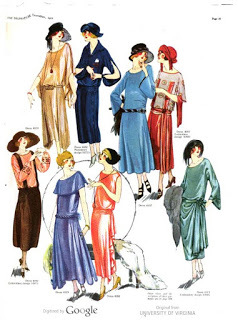 December 1922 fashions
Loretta reports:
December 1922 fashions
Loretta reports:We complete this year's historical fashion plate cycle with a set of patterns and fashion news from the Delineator for December 1922 .
The New in New York by Evelyn Dodge
“The jacket blouse and the blouse jacket have elbowed their way well to the front of the Fifth Avenue windows and New York almost killed a very charming style with the kindness of its enthusiastic reception. The jacket and the blouse are twins so much alike that their own mother-designer has difficulty in telling them apart. In many cases they can be used interchangeably, but as the weather grows colder the blouse jacked is more and more made of the fur cloths and heavier clokies, while the jacket blouse appears in the matelassés, crêpe silks and velvets.
"The best Fifth Avenue houses are making their separate skirts quite generally with camisole bodies instead of inside belts. There are two reasons why the camisole is a better bet than the belt with the present styles. If the belt is large enough to rest low on the hip, it is almost impossible to keep in its proper place. If it fits the normal waistline, it has a curiously high-waisted look, an optical delusion produced by the very general acceptance of the lowered waistline. Practically all blouses, except the under-the-sweater type, are worn outside the skirt. If the blouse is white or partially transparent, the upper part of the skirt shows through when it is mounted on a belt. The camisole does not bring the skirt above the low waistline and it can be made of white China silk if it is to be worn under light, transparent blouses. The camisole top also make an excellent foundation for the jerseys or open-work sweaters that are worn so much in place of blouses ...
"With longer skirts and the more formal type of draped dress the bobbed-hair girl has had to grow up overnight. The closer hair-dressing is partly responsible for the vogue of the long earring, which for evening reaches almost to the shoulder. Some of them seen in the Fifth Avenue windows are made of heavy red gold in long, narrow Egyptian designs triangular in shape. Crystal is very smart for evening or afternoon. Very large hoop earrings are also worn in fine lines of jet or jade or amber.”
 December 1922 fashion descriptions
The Delineator, which sells Butterick patterns, offers pages and pages of fashions each month, including children’s clothes, underwear, and sleepwear, as well as ideas for low-cost gifts. If you’re interested in this era, it’s well worth a look.
December 1922 fashion descriptions
The Delineator, which sells Butterick patterns, offers pages and pages of fashions each month, including children’s clothes, underwear, and sleepwear, as well as ideas for low-cost gifts. If you’re interested in this era, it’s well worth a look. Clicking on the image will enlarge it. Clicking on a caption link will take you to the source, where you can learn more and enlarge images as needed.
Published on December 02, 2018 21:30
December 1, 2018
Breakfast Links: Week of November 26, 2018
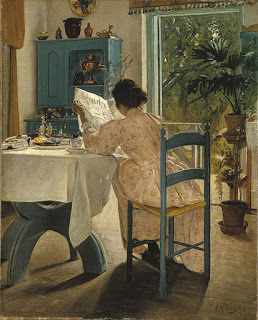 Breakfast Links are served! Our weekly round-up of favorite links to other web sites, articles, blogs, and images via Twitter.
Breakfast Links are served! Our weekly round-up of favorite links to other web sites, articles, blogs, and images via Twitter.• Guide dogs in medieval art and writing.
• The exceptional wedding shoes of Mary Wise Farley , 1764.
• The tangled history of weaving with spider-silk .
• Forget the movies: the original ghostbuster was 19thc scholar Eleanor Sidgewick .
• Wonderful personal memories of growing up in Jewish American Detroit: the fiddle and the city.
• Yes, they did it: bust enhancement in 19thc women's dresses.
• A breathtaking reconstruction 1,300-year-old Anglo-Saxon helmet from the Staffordshire Hoard.
• Self-taught poet Hester Pulter wondered in the 17thc "Why must I forever be confined?" - now her poems are online for all to see.
• A striking 1937 gold lame wedding outfit designed and stitched by the bride herself.
• Tanuki, the shape-shifting raccoon-dog: mischief, magic, and change in the Japanese countryside.
• A visit to the house of 18thc artist William Hogarth .
• The Statue of Liberty's original torch gets a new home.
• "Battalion of Life": American women's hospitals and the First World War.
• Contested rites: the fascinating roots of America's Thanksgiving holiday.
• Protecting children in traffic: a brief history of crossing guards .
• You may be cool, but you'll never be Cordell Jackson "the rockin' granny" cool.
Hungry for more? Follow us on Twitter @2nerdyhistgirls for fresh updates daily.
Above: At Breakfast by Laurits Andersen Ring. Private collection.
Published on December 01, 2018 14:00
November 29, 2018
Friday Video: Dressing Queen Elizabeth I
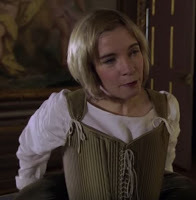 Loretta reports:
Loretta reports:We’ve been doing quite a few “getting dressed” videos, yet I don’t hesitate to offer one more because, well, historical clothing. And then, too, it’s Lucy Worsley!
Video: Does my bum look big in this? - Tales from the Royal Wardrobe with Lucy Worsley - BBC One
Image is a screen shot of the video.
Readers who receive our blog via email might see a rectangle, square, or nothing where the video ought to be. To watch the video, please click on the title to this post (which will take you to our blog) or the video title (which will take you to YouTube).
Published on November 29, 2018 21:30
November 28, 2018
A Sparkling Length of 18thc Gold Lace from the Massachusetts Historical Society
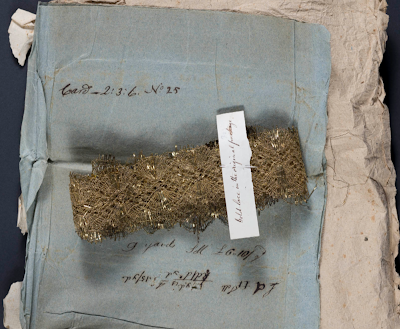 Susan reporting,
Susan reporting,Earlier this month I visited the latest exhibition at one of my favorite places for research and inspiration, the Massachusetts Historical Society in Boston, MA. Called Fashioning the New England Family, it's a truly breathtaking exhibition, featuring clothing, accessories, textiles, and embroidery worn and made by New Englanders.
The majority of the pieces are drawn from the MHS collections, and many have never before or only rarely been seen by the public. There's so much here: Abigail Adams's copper-colored silk gown; Thomas Hancock's walking stick crowned by a clenched ivory fist; Governor John Leverett's 17thc buff coat worn to fight under Oliver Cromwell in the English Civil War; Rachael Hartwell's light-as-air 1890s wedding dress. The history of the wearers is woven into each piece, and the presentation is thoughtful and beautifully displayed. The exhibition is free to the public, and runs through April 6, 2019. See here for more information.
I'll be featuring highlights from the exhibition in upcoming blog posts, and I'm starting with one of the smaller items. It's also among the most stunning. Some time during the mid-18thc, this length (unfolded, it measures 283 cm x 5 cm) of gold wire bobbin lace was made in Europe. Whether bought by an individual there or imported to the American colonies to be sold in a shop here, the lace was purchased and carefully wrapped in blue paper with the price written in iron gall ink. For whatever reason, the lace was never used, but instead put away in its original paper wrapping.
Metallic lace was a costly and luxurious trim, designed to sparkle in 18thc candlelit rooms. It could be used to adorn a woman's gown or a man's waistcoat, or even the cap of a special baby. (I immediately thought of the similar gold bobbin lace that was incorporated in this mat embroidered c1780 by Elizabeth Schuyler Hamilton.) Metallic lace was usually a blend of gold and silver or other metals, and over time and wear often tarnished and lost its shine.
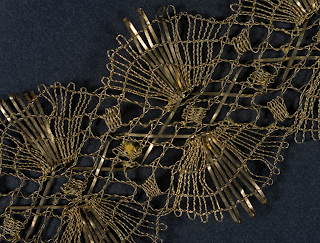
But this particular length of lace remains as bright as new, the intricate woven gold glowing against the blue paper. When the lace was given to the MHS, it was accompanied by a handwritten note from Susan Holmes Upham (1804-1877): "Gold lace given me with other old-fashioned things by my mother." It must indeed have been an old-fashioned curiosity by the mid-19thc. Today it's a sparkling link through the centuries to the shop of the now-forgotten milliner or mantua-maker who made the sale, tallied the price, and wrapped the lace, and the (I hope!) satisfied customer who carried the new purchase home.
Many thanks to Anne Bentley and Kimberly Alexander for giving me a special tour of the exhibition, and for including me in the planning from the earliest stages.
Gold Wire Bobbin Lace, mid-18thc, European. Massachusetts Historical Society.
Photographs courtesy of Massachusetts Historical Society.
Published on November 28, 2018 20:17
November 26, 2018
Victorian Fly-Cages
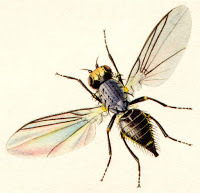 Napomyza lateralisLoretta reports:
Napomyza lateralisLoretta reports:From the Annals of Obscurity:
Mr. Bumble sat in the workhouse parlour, with his eyes moodily fixed on the cheerless grate, whence, as it was summer time, no brighter gleam proceeded, than the reflection of certain sickly rays of the sun, which were sent back from its cold and shining surface. A paper fly-cage dangled from the ceiling, to which he occasionally raised his eyes in gloomy thought; and, as the heedless insects hovered round the gaudy network, Mr. Bumble would heave a deep sigh, while a more gloomy shadow overspread his countenance. Mr. Bumble was meditating; it might be that the insects brought to mind, some painful passage in his own past life.—Charles Dickens, Oliver TwistBehold me gazing ceilingward. Fly-cage? Paper fly-cage? Apparently, I’d happened upon one of those numerous 19th century articles, like ticket porters , that were once a necessity and part of everyday life, and now extinct. The fly-cage wasn't an easy thing to track down, and I'm grateful to Lonely Planet for guiding me.
According to the Dickensian these fly-cages "were usually made of coloured perforated paper folded into globular or bell-shaped forms suspended from the ceiling. They were not intended for "cages" but as places in which flies could settle so that their buzzing should not be an annoyance."—the Dickensian Vols 46-47; Dickens Fellowship, 1949Apparently, however, it wasn’t just to stop the annoying buzzing, but the annoying fly specks on ceilings and walls.
 Point Lace Fly-Cage
Point Lace Fly-Cage
“Every cottager who has hung the gaudy-coloured paper “fly-cages” in his room, to prevent his clean whitewashed roof and walls from being dirtied by common house-flies, has practically availed himself of the attraction which bright colours have for even these non-flower-loving insects.”—John Ellor Taylor, Flowers: Their Origin, Shapes, Perfumes, and Colours 1878Though I've so far found no lovely colored illustrations of the paper fly-cages, Cassell's Household Guide, Volume 2 1869 explains how to make one .
If you’d like something more elaborate (though some of us would wonder why), you can also crochet one. Yes, you read correctly. You can crochet your own fly-cage. Mrs Jane Weaver provides instructions in the Peterson Magazine of 1858.
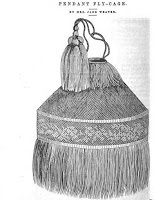 Pendant Fly-Cage
Pendant Fly-Cage
Links to better illustrations of the paper fly-cage will be warmly welcomed.
Images: Napomyza lateralis; Point lace fly cage , from Cassell's household guide, Volume 2 1869; Pendant fly-cage from the Peterson Magazine, Volumes 33-34
Clicking on the image will enlarge it. Clicking on a caption link will take you to the source, where you can learn more and enlarge images as needed.
Published on November 26, 2018 21:30
November 21, 2018
Happy Thanksgiving!
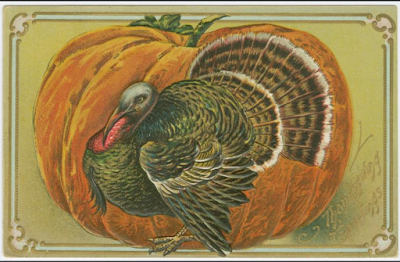 Loretta and Susan reporting,
Loretta and Susan reporting,Turkey time! Americans will be celebrating the Thanksgiving holiday this Thursday, November 22. Since Thanksgiving also always seems to coincide with our deadlines and general manic bursts of writing, we'll be be keeping one hand on the keyboard and the other on the pumpkin pie.
We'll be taking a few days off from blogging, too, since we imagine you're all just as busy as we are. But please know that whatever the season, we're endlessly thankful for you, our readers all around the world. You're the best.
Have a wonderful - and delicious - holiday.
Above: Thanksgiving Greetings, holiday postcard, 1907, New York Public Library.
Published on November 21, 2018 14:00
November 20, 2018
From the Archives: How (Not) to Dress a 17thc Puritan Maid
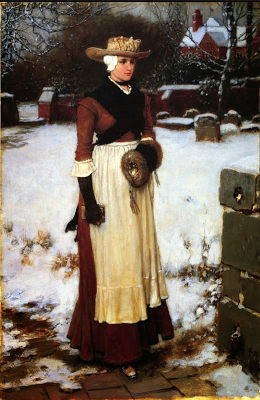 Susan reporting,
Susan reporting,With Thanksgiving just round the corner and festive Pilgrims featured in every advertisement, let's revisit one of our most popular posts with a "Puritan maid."
Historical clothing is one of our favorite topics on this blog, and readers of both our posts and books will know how hard we try to get things *right* when in comes to what people were wearing in the past. Yet I'm also willing to concede that there can be considerable wiggle-room when it comes to theatrical costumes (no one really expects Cinderella to wear a perfect replica 18th c. gown, do they?) and other artistic expressions of past fashion.
But what happens when that artist's vision becomes such a potent image that it wipes the real thing clear away?
That was my thought while reading one of my favorite blogs, historian Donna Seger's Streets of Salem. A recent post featured the 19th c. Anglo-American painter George Henry Boughton (1833-1905), and how his paintings of 17th c. New England Puritans have influenced how we today imagine those early settlers. (Read her post here .) She's right: Boughton's paintings have illustrated countless school history books, and his version of Puritan dress is still widely accepted as the real thing. In fact, when I did a search for the painting, left, the Google best guess that comes up is "Puritan fashion", followed by links to a teaching site that labels this as an example of "colonial clothing."
Except that it isn't. Like most history-painters, Boughton's intentions were the best, but what this young woman is wearing bears no more real resemblance to 17th c. clothing than the sturdy stone walls and substantial brick buildings in the background do to mid-17th c. architecture in the Massachusetts Bay Colony. Boughton painted his Puritan maiden in 1875, and to me her expression and posture seem more akin to a fashionable lady of that era; compare her with the lady in James Tissot's Portrait , also painted in 1875.
But it's the costume that Boughton contrived for his model that fascinates me the most. I'm guessing that, like many artists, he had a collection of antique and fancy-dress clothing in his studio, and he assembled an outfit from bits and pieces that looked right to him. To be fair to Boughton, he was trying to create an artistic mood, a somber, thoughtful reverie set in the past, rather than a 17th c. fashion plate. In 1875, people regarded historical clothing as old clothes to be worn to masquerades (no one loved fancy-dress more than the Victorians), and the academic study of dress and fashion was in its infancy.
Still, I'd like to offer a challenge to you. Among our readers, there are many art historians, re-enactors, costume historians, historic seamstresses and tailors, and others of you who know your historical fashion. How many different elements and eras can you see represented in this young woman's costume?
Above: A Puritan Maiden, by George Henry Boughton, 1875, Munson-Williams-Proctor Institute.
Published on November 20, 2018 04:25
November 17, 2018
Breakfast Links: Week of November 12, 2018
 Breakfast Links are served! Our weekly round-up of favorite links to other web sites, articles, blogs, and images via Twitter.
Breakfast Links are served! Our weekly round-up of favorite links to other web sites, articles, blogs, and images via Twitter.• Lost identity of 150-year-old body discovered in New York City discovered.
• Women at sea : Ann Johnson and Abbie Clifford.
• "The joy of my life": seeing-eye dogs , disabled veterans and civilians, and World War One.
• "A revolution in female manners": the political portraiture of Mary Wollstonecroft .
• "I'll glut you with gold": the strange ambivalence of the treasure map .
• Follow the thread for all the amazing images: the American Revolution as imagined in 1861 by a Japanese artist and author who had never left Japan.
• Ada Lovelace and her mother Annabella Byron : the Countess of Computing and the Princess of Parallelograms.
• A toy monkey that escaped Nazi Germany and reunited a family.
• Anna Morandi , the 18thc Italian anatomist and sculptor who brought dead bodies to light.
• Pyrotechnia : an Elizabethan fireworks guide includes how to make a firework dragon.
• The last velvet merchant in Venice.
• Archaeologists and medical historians discover how castration affected the skeleton of famed 18thc opera singer Farinelli .
• An up-market new suburb in late 17thc London: the development of St. James's .
• Child-stealing in Regency England.
• Nineteenth century Bostonian • Don't try these at home: eight dishes made by notorious poisoners.
• Creeping (or creepy?) baby doll patent model, 1871.
• A c1870 silk dress with an ingenious built-in method for lifting the hem away from a dirty street (be sure to click on "additional images.")
• The Tenement Museum in NYC maps a century of deadly diseases and their human stories.
Hungry for more? Follow us on Twitter @2nerdyhistgirls for fresh updates daily.
Above: At Breakfast by Laurits Andersen Ring. Private collection.
Published on November 17, 2018 14:00
November 15, 2018
Friday Video: Pearls & Diamonds Worn by Queen Marie Antoinette
Susan reporting,
Diamonds may be forever, but the jewelry that enhances them seldom is. Precious stones can be recut and reset, and precious metals reformed into new settings and pieces. Royal jewels are among the most transitory of all, especially those belonging to a doomed royal family in the midst of a revolution.
Queen Marie Antoinette of France was famous for her jewels, and it can be argued that her love for diamonds helped lead to her tragic downfall. This week, a few of her pieces (along with other jewels belonging to the Bourbon Parma family) came up for auction through Sotheby's. As can be imagined, the interest in jewels with such a history was considerable, and this video features the rarest of the pieces in the auction, and beautiful things they are, too.
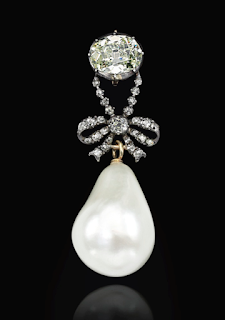
Pre-auction sales estimates often tend to be low, but I imagine even Sotheby's was stunned by the final sales figures. The small enamel and seed-pearl pocket watch engraved with the queen's monogram and featured in the video was estimated to sell for around $8,000-9,000; it sold for $248,203. The triple-strand pearl necklace with the diamond clasp had an estimate of around $198,000-297,000; it sold for $2,278,499.
But the real star was the large pearl pendant on a diamond bow, right. The pre-sale estimate was around $1,000,000-2,000,000. The final price? A staggering $36,165,090.
See here for photos and a listing of all the pieces in the auction.
If you receive this post via email, you may see a blank space or black box where the video should be. Please click here to view the video.
Published on November 15, 2018 18:50
November 12, 2018
From the Archives: Harriette Wilson on Virtue
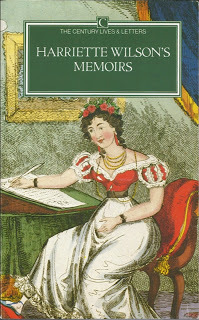 Loretta reports:
Loretta reports:The Regency era courtesan Harriette Wilson belonged to the sorority called Girls Just Want To Have Fun. Here’s her take on virtue:
~~~
There certainly was much aggravation of sin, in my projected criminal intercourse with the Marquis of Worcester. Many women, very hard pressed par la belle nature, intrigue because they see no prospect nor hopes of getting husbands; but I, who might, as everybody told me, and were incessantly reminding me, have, at this period, smuggled myself into the Beaufort family, by merely declaring to Lord Worcester, with my finger pointed towards the North—that way leads to Harriette Wilson’s bedchamber; yet so perverse was my conscience, so hardened by what Fred Bentinck calls, my perseverance in loose morality, that I scorned the idea of taking such an advantage of the passion I had inspired, in what I believed to be a generous breast, as might, hereafter, cause unhappiness to himself, while it would embitter the peace of his parents.
Seriously I have but a very confused idea of what virtue really is, or what it would be at. For my part, all the virtue I ever practised, or desire to learn, was such as my heart and conscience dictated.
Now the English Protestant ladies’ virtue is chastity! There are but two classes of women among them. She is a bad woman the moment she has committed fornication; be she generous, charitable, just , clever, domestic, affectionate, and ever ready to sacrifice her own good to serve and benefit those she loves, still her rank in society is with the lowest hired prostitute. Each is indiscriminately avoided, and each is denominated the same—bad woman, while all are virtuous who are chaste.
…The soldier’s virtue lies in murdering as many fellow creatures as possible, at the command of any man, virtuous or vicious, who may happen to be his chief, no matter why or wherefore.
The French ladies’ virtue is, generally speaking, all comprised and summed up in one single word and article—bienséance!*
*propriety
~~~
Excerpt from The Memoirs Of Harriette Wilson , which were first published in 1825.
You can read the first two volumes from the 1909 edition online here . And for further insight into this fascinating woman, you might want to look into The Courtesan’s Revenge: The Life of Harriette Wilson, the Woman Who Blackmailed the King .
Published on November 12, 2018 21:30



